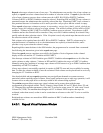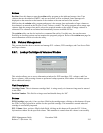note that this can also mean that side 0 of the cartridge is mounted.
PVR Server. The descriptive name of the PVR which manages the cartridge.
• Cartridge Type. The HPSS media type corresponding to this cartridge. This controls which the
type of drive in which the cartridge can be mounted.
Manufacturer. The Manufacturer string specified when the cartridge was imported.
Lot Number. The Lot Number string specified when the cartridge was imported.
Service Start Date. The date and time when the cartridge was imported.
Maintenance Date. If the maintenance is performed on the cartridge, for example by re-tensioning it,
this field can be set to record the date of the maintenance. The format for entering the date is given to the
right of the field. This format can be changed with the -D option to the hpssgui startup script.
Last Mounted Date. The date and time when the cartridge was last mounted.
Mounts In Service. The number of times the cartridge has been mounted by HPSS since it was imported.
Mounts Since Maintenance. The number of times the cartridge has been mounted since its last
maintenance. Click the Reset button to the right of this field to reset the value to zero. This field is not
automatically reset when Maintenance Date is changed.
Operational State. This will always be Enabled.
Usage State. This should always be Active.
Administrative State. This will always be Unlocked.
Mount Status. The mount status of the cartridge. Possible values are:
• Mount Pending
• Mounted
• Dismount Pending
• Dismounted
• Eject Pending
• Checked In
• Check-In Pending
• On Shelf
• Check-Out Pending
• Move Pending
• Move Shelf Pending
Job Id. The job identifier associated with the cartridge. A value of zero indicates that there is not job
associated with the cartridge (i.e. when the cartridge is not mounted).
Location Type. The type of cartridge location information being displayed. Possible values are:
• None - No location information is available.
HPSS Management Guide November 2009
Release 7.3 (Revision 1.0) 268


















